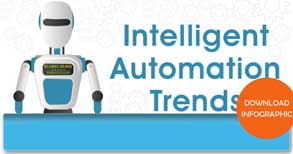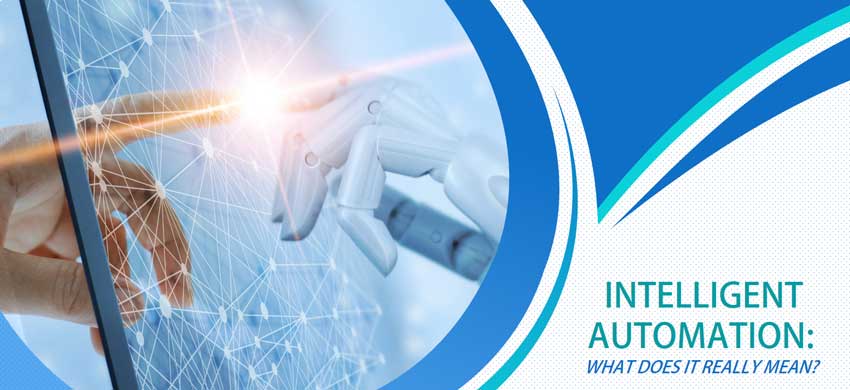A version of this article was first published here AI and the IA Network: Intelligent Automation Week in Chicago: An excerpt is provided below.
What we talk about when we talk about automation is reducing the need for humans to be involved in a particular task. This is for a variety of reasons: increasing safety, increasing precision, reducing cost and increasing output. Automation is an “automatically controlled operation of an apparatus, process or system by mechanical or electronic devices that take the place of human labor,” according to Merriam Webster. Pay close attention to that last qualifier. Over the years, various levels of automation have impacted thousands upon thousands of processes.
So what does it mean to apply intelligent automation? How is this different from the billions of lines of code that automate millions of processes every day? Some explanations fail to distinguish it from the traditional “remove human labor” variety. Others clumsily include complex topics such as “artificial intelligence,” “machine learning” and “natural language processing” to differentiate “intelligent automation” from traditional automation. However, few explanations really provide insight into how these technical concepts really change the game. It is critical to understand the impact of an intelligent automation project beyond simply continuing with existing processes.
Tackling More Complex Tasks with IA
The key distinction that drives a definitive difference between the two lies within the nature of the target process itself. Simply put, traditional automation focuses on automating discrete and routine processes while intelligent automation tackles automation of multi-step and high-variance processes. Intelligent automation significantly expands the realm of scenarios available to automate.
Next comes the technology and approaches involved. With traditional automation focused on highly repeatable processes, there is no need to analyze vast quantities of conditions and outcomes. With a finite range of clearly identified situations, you can very precisely and efficiently program a machine to reliably perform a job.
General vs. Applied Machine Learning
When dealing with more complex and variable processes having different inputs, variables and outcomes, automation using rules-based approaches is unfeasible or impossible. Enter machine learning where models that govern behavior can be efficiently constructed from the ingestion of millions of scenarios. These models offer more flexibility to handle different inputs because the machine learning algorithms can analyze an order of magnitude more data than an army of people. The key here is that machine learning is applied to a given problem. There is no such thing as general machine learning with automation. It must be given form to have a function. Intelligent automation focuses on multi-step, highly variable and specific processes.
In automation and IA, we started with a general description of the target process, not the technology. As with any solution, you start by defining the problem. To illustrate the difference between traditional and intelligent automation, let’s look at cars. Driving a car involves many discrete processes. For example, managing speed requires changing gears. Go up a hill, and it is necessary to downshift to maintain speed. Driving on a flat highway allows shifting up to a more fuel-efficient gear. These different variables are all known, and therefore, straightforward to encode into a set of rules that can be automated. Enter the automatic transmission. The concept of automating gear selection arrived in the early 1900s with the first hydraulic transmission introduced in the 1930s.
Fast forward a 100 years, and we are finally at a stage where we can consider intelligent automation for transportation in the form of self-driving vehicles. No longer limited to discrete and repeatable processes, the concept of autonomous vehicles stitches together many different, highly variable tasks. Apart from availability of various sensors as input, the key force enabling this IA is the use of deep learning-based artificial intelligence that can process enormous amounts of data and adapt.
Deep Learning-based Artificial Intelligence
While traditional automation makes heavy use of subject matter experts (SMEs) to create the rules for tasks such as the automation of gear selection/changes, intelligent automation requires SMEs and data science to encode the rules and assist the system to produce the expected results such as the ability to navigate a route from home to work.
The same neural network that can operate a vehicle cannot automate your accounts payable process. The key to IA—which uses machine learning—is in the specificity of the process that allows for proper training of the machine learning algorithms to produce accurate, reliable and expected output.
Moving Toward Unattended Automation
Ultimately, with any automation, we can come full-circle and talk about results: the ability to reduce the need for humans to be involved in a process by reliably and precisely automating tasks. Increasingly, the focus will be on a concept called “unattended automation” where there is no need for a person to oversee actions of a system. Just as no one would expect to oversee each action of a self-driving car, organizations will increasingly expect to divert highly valuable human cognition to more valuable tasks. Because of simple rote tasks, traditional automation could make use of simpler techniques in order to achieve automation without “humans in the loop.”
When it comes to successfully applying intelligent automation focused on complex, variable and multi-step processes, selecting machine-learning techniques applied to specific tasks and implementing them using a data science approach are essential to produce reliable results.

Also, we have the latest trends in intelligent document automation infographic, “Intelligent Automation Trends: How the Digital Workforce Takes Advantage of Document Automation Solutions,” based on the recent AIIM Survey of 100 leaders in capture.




